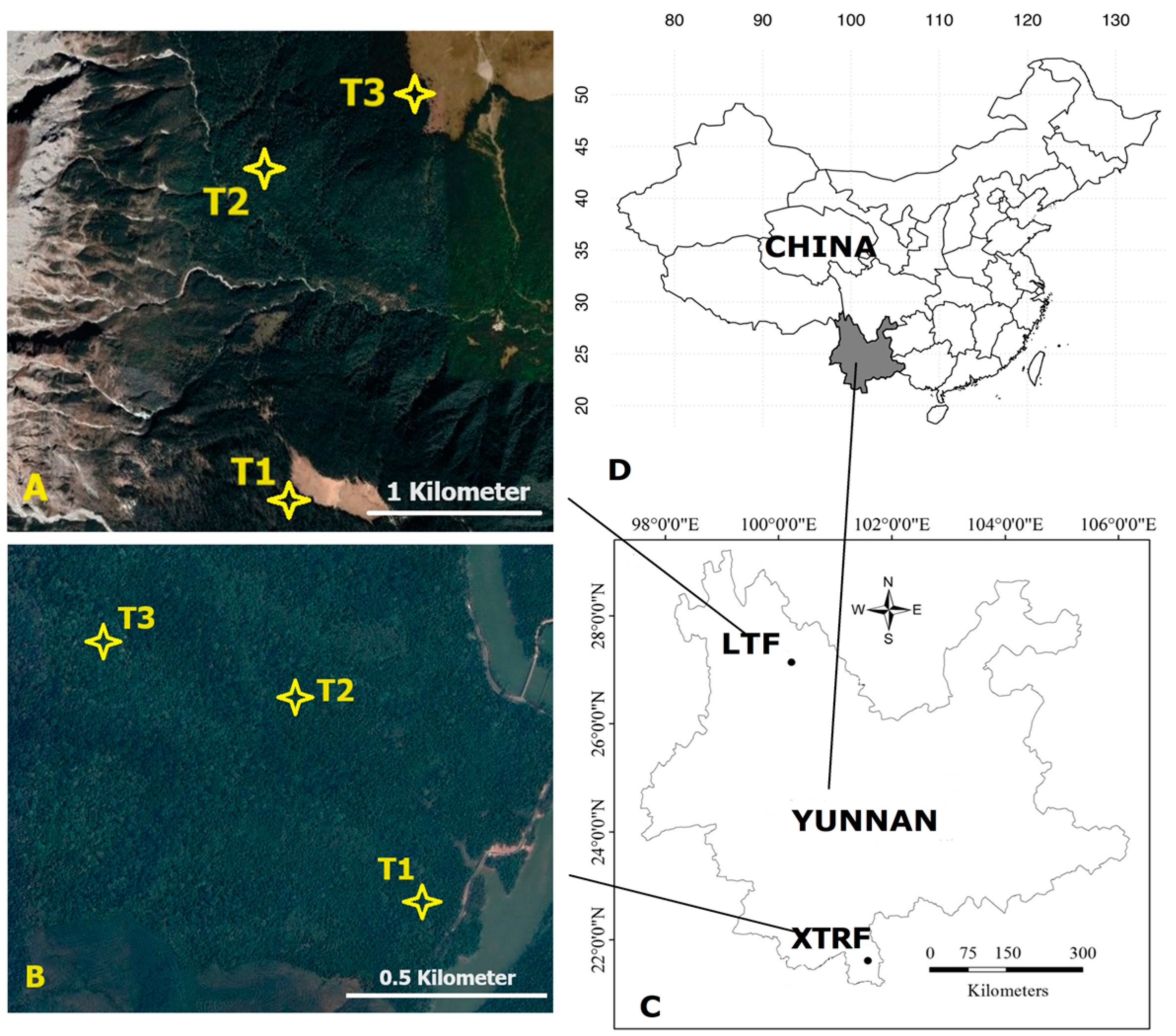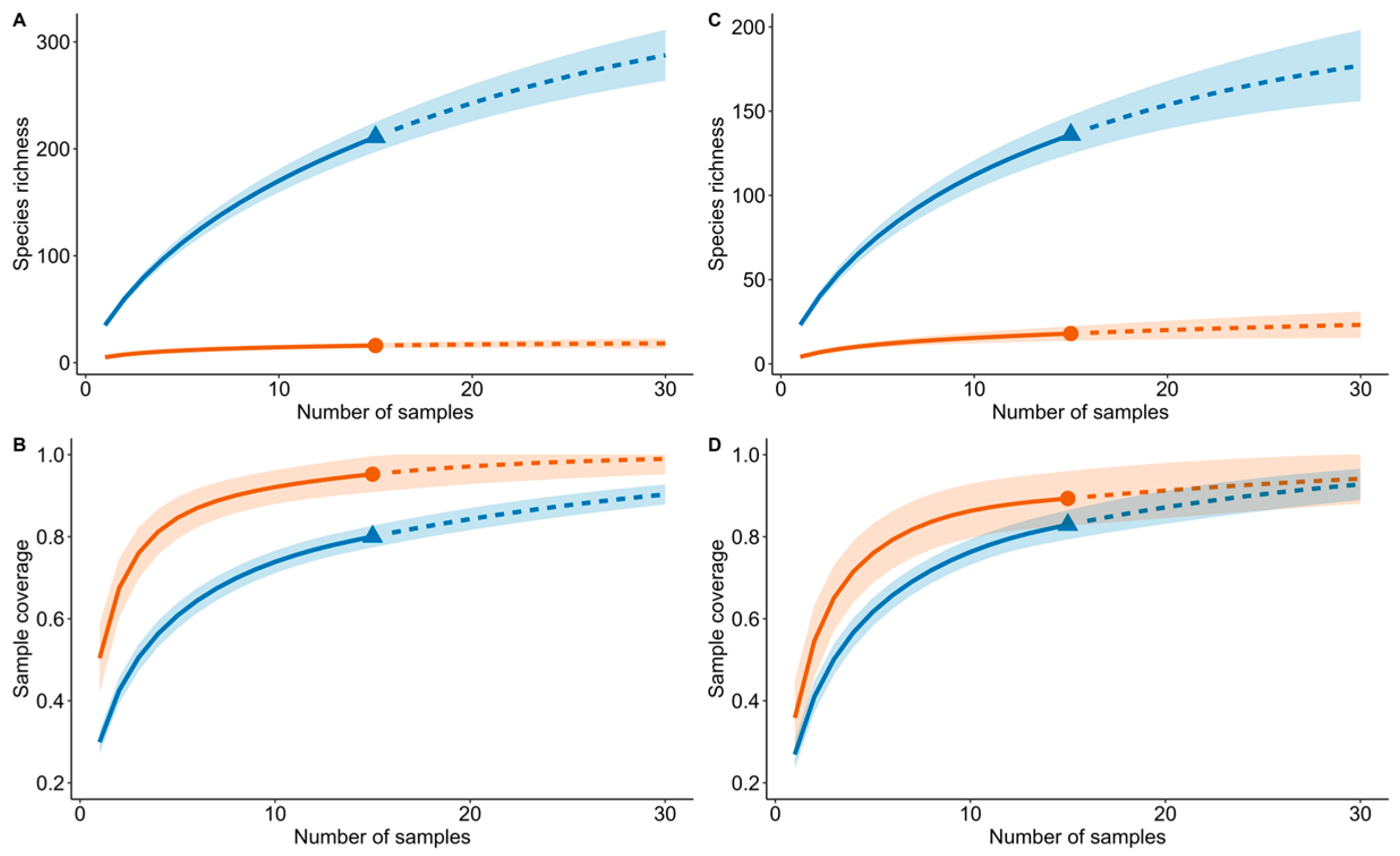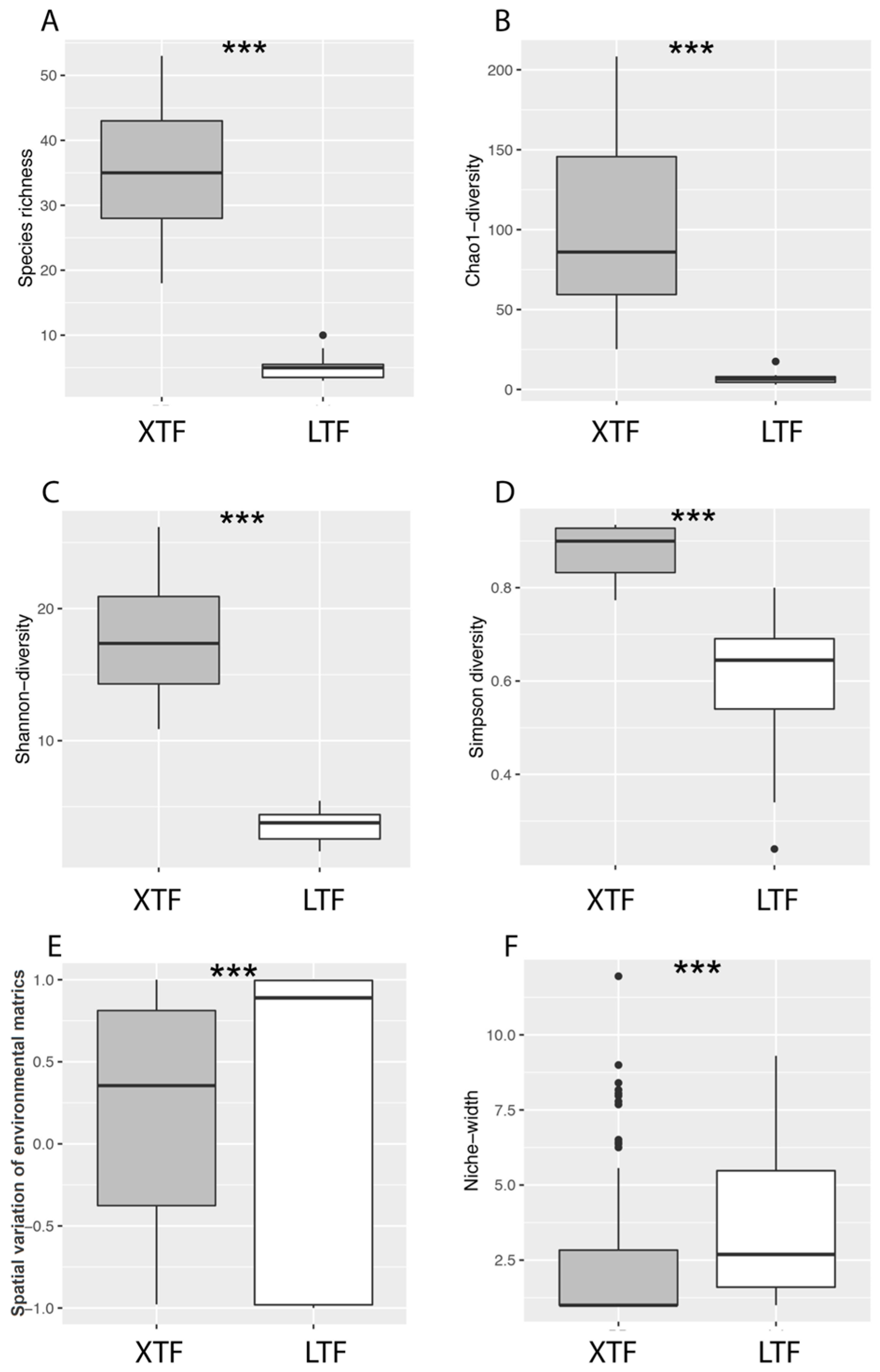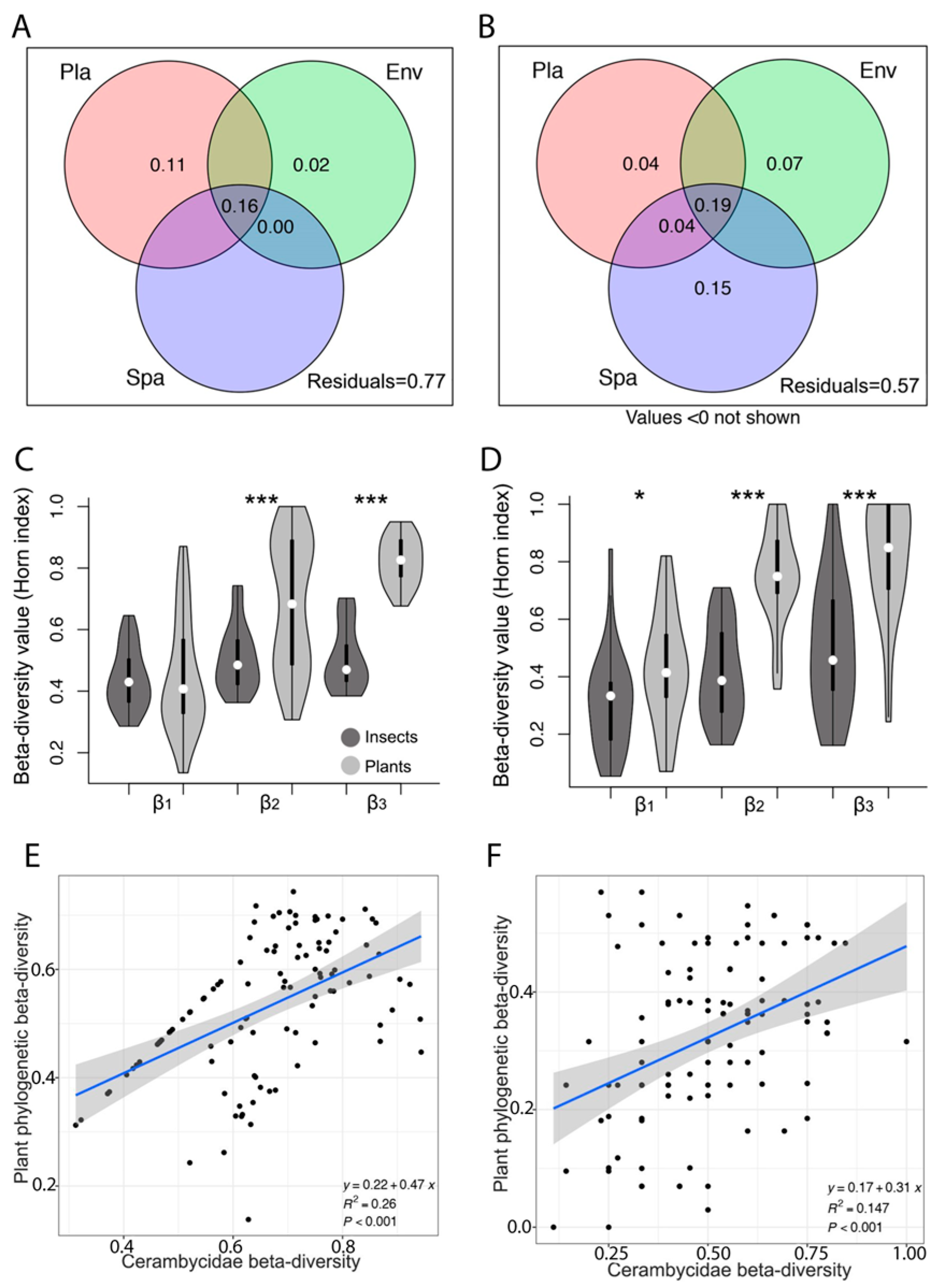Differential Dominance of Ecological Processes Shapes the Longhorn Beetle Community in Tropical Rainforests and Temperate Forests of Southwest China
Abstract
Simple Summary
Abstract
1. Introduction
2. Materials and Methods
2.1. Study Sites and Sampling Design
2.2. Data Collection
2.2.1. Longhorn Beetle Sample Collection
2.2.2. Plant Sample Collection
2.2.3. Environmental Data Collection
2.3. Data Analyses
2.3.1. Sampling Sufficiency
2.3.2. Longhorn Beetle and Plant Community Composition and Environmental Variation
2.3.3. Influence of Plant Community, Environmental Factors, and Spatial Distance on Longhorn Beetle Community Variation
2.3.4. Estimating Community Assembly Processes with Normalised and Modified Stochasticity Ratios
2.3.5. Software Program
3. Results
3.1. Longhorn Beetle and Plant Surveys and Sampling Sufficiency Estimation
3.2. Longhorn Beetle and Plant Community Composition and Environmental Variation Estimation
3.3. Influence of Plant Community, Environmental Factors, and Spatial Distance on Longhorn Beetle Community Variation
3.4. Estimating Community Assembly Processes with Normalised and Modified Stochasticity Ratios
4. Discussion
4.1. Coexistence Patterns of Cerambycidae across Different Climate Zones
4.2. Effects of Biotic and Abiotic Factors on Cerambycidae
4.3. Effects of Deterministic and Stochastic Processes on Cerambycidae
4.4. Different Coexistence Processes across Different Climatic Zones
4.5. Limitations of the Study and Recommendations for Future Research
Supplementary Materials
Author Contributions
Funding
Data Availability Statement
Acknowledgments
Conflicts of Interest
References
- Dini-Andreote, F.; Stegen, J.C.; Van Elsas, J.D.; Salles, J.F. Disentangling mechanisms that mediate the balance between stochastic and deterministic processes in microbial succession. Proc. Natl. Acad. Sci. USA 2015, 112, E1326–E1332. [Google Scholar] [CrossRef]
- Stegen, J.C.; Lin, X.; Fredrickson, J.K.; Chen, X.; Kennedy, D.W.; Murray, C.J.; Rockhold, M.L.; Konopka, A. Quantifying community assembly processes and identifying features that impose them. ISME J. 2013, 7, 2069–2079. [Google Scholar] [CrossRef]
- Vellend, M. Conceptual synthesis in community ecology. Q. Rev. Biol. 2010, 85, 183–206. [Google Scholar] [CrossRef]
- Chase, J.M.; Myers, J.A. Disentangling the importance of ecological niches from stochastic processes across scales. Philos. Trans. R. Soc. B Biol. Sci. 2011, 366, 2351–2363. [Google Scholar] [CrossRef]
- Hubbell, S.P. The unified neutral theory of biodiversity and biogeography (MPB-32). In The Unified Neutral Theory of Biodiversity and Biogeography (MPB-32); Princeton University Press: Princeton, NJ, USA, 2011; ISBN 1400837529. [Google Scholar]
- Martiny, J.B.H.; Eisen, J.A.; Penn, K.; Allison, S.D.; Horner-Devine, M.C. Drivers of bacterial β-diversity depend on spatial scale. Proc. Natl. Acad. Sci. USA 2011, 108, 7850–7854. [Google Scholar] [CrossRef]
- Ramette, A.; Tiedje, J.M. Multiscale responses of microbial life to spatial distance and environmental heterogeneity in a patchy ecosystem. Proc. Natl. Acad. Sci. USA 2007, 104, 2761–2766. [Google Scholar] [CrossRef] [PubMed]
- Dini-Andreote, F.; Pylro, V.S.; Baldrian, P.; Van Elsas, J.D.; Salles, J.F. Ecological succession reveals potential signatures of marine–terrestrial transition in salt marsh fungal communities. ISME J. 2016, 10, 1984–1997. [Google Scholar] [CrossRef]
- Zhou, J.; Ning, D. Stochastic community assembly: Does it matter in microbial ecology? Microbiol. Mol. Biol. Rev. 2017, 81, e00002-17. [Google Scholar] [CrossRef]
- Tian, J.; Qiao, Y.; Wu, B.; Chen, H.; Li, W.; Jiang, N.; Zhang, X.; Liu, X. Ecological succession pattern of fungal community in soil along a retreating glacier. Front. Microbiol. 2017, 8, 1028. [Google Scholar] [CrossRef] [PubMed]
- Jurburg, S.D.; Nunes, I.; Stegen, J.C.; Le Roux, X.; Priemé, A.; Sørensen, S.J.; Salles, J.F. Autogenic succession and deterministic recovery following disturbance in soil bacterial communities. Sci. Rep. 2017, 7, 45691. [Google Scholar] [CrossRef] [PubMed]
- Anderson, M.J.; Crist, T.O.; Chase, J.M.; Vellend, M.; Inouye, B.D.; Freestone, A.L.; Sanders, N.J.; Cornell, H.V.; Comita, L.S.; Davies, K.F. Navigating the multiple meanings of β diversity: A roadmap for the practicing ecologist. Ecol. Lett. 2011, 14, 19–28. [Google Scholar] [CrossRef]
- Morlon, H.; Chuyong, G.; Condit, R.; Hubbell, S.; Kenfack, D.; Thomas, D.; Valencia, R.; Green, J.L. A general framework for the distance–decay of similarity in ecological communities. Ecol. Lett. 2008, 11, 904–917. [Google Scholar] [CrossRef]
- Wang, X.-B.; Lü, X.-T.; Yao, J.; Wang, Z.-W.; Deng, Y.; Cheng, W.-X.; Zhou, J.-Z.; Han, X.-G. Habitat-specific patterns and drivers of bacterial β-diversity in China’s drylands. ISME J. 2017, 11, 1345–1358. [Google Scholar] [CrossRef]
- Wang, J.; Shen, J.I.; Wu, Y.; Tu, C.; Soininen, J.; Stegen, J.C.; He, J.; Liu, X.; Zhang, L.; Zhang, E. Phylogenetic beta diversity in bacterial assemblages across ecosystems: Deterministic versus stochastic processes. ISME J. 2013, 7, 1310–1321. [Google Scholar] [CrossRef]
- Wu, W.; Lu, H.-P.; Sastri, A.; Yeh, Y.-C.; Gong, G.-C.; Chou, W.-C.; Hsieh, C.-H. Contrasting the relative importance of species sorting and dispersal limitation in shaping marine bacterial versus protist communities. ISME J. 2018, 12, 485–494. [Google Scholar] [CrossRef] [PubMed]
- Nemergut, D.R.; Schmidt, S.K.; Fukami, T.; O’Neill, S.P.; Bilinski, T.M.; Stanish, L.F.; Knelman, J.E.; Darcy, J.L.; Lynch, R.C.; Wickey, P. Patterns and processes of microbial community assembly. Microbiol. Mol. Biol. Rev. 2013, 77, 342–356. [Google Scholar] [CrossRef] [PubMed]
- Ferger, S.W.; Schleuning, M.; Hemp, A.; Howell, K.M.; Böhning-Gaese, K. Food resources and vegetation structure mediate climatic effects on species richness of birds. Glob. Ecol. Biogeogr. 2014, 23, 541–549. [Google Scholar] [CrossRef]
- Vollstädt, M.G.R.; Ferger, S.W.; Hemp, A.; Howell, K.M.; Töpfer, T.; Böhning-Gaese, K.; Schleuning, M. Direct and indirect effects of climate, human disturbance and plant traits on avian functional diversity. Glob. Ecol. Biogeogr. 2017, 26, 963–972. [Google Scholar] [CrossRef]
- Buckley, L.B.; Miller, E.F.; Kingsolver, J.G. Ectotherm thermal stress and specialization across altitude and latitude. Integr. Comp. Biol. 2013, 53, 571–581. [Google Scholar] [CrossRef] [PubMed]
- Sheldon, K.S.; Tewksbury, J.J. The impact of seasonality in temperature on thermal tolerance and elevational range size. Ecology 2014, 95, 2134–2143. [Google Scholar] [CrossRef]
- Sunday, J.M.; Bates, A.E.; Kearney, M.R.; Colwell, R.K.; Dulvy, N.K.; Longino, J.T.; Huey, R.B. Thermal-safety margins and the necessity of thermoregulatory behavior across latitude and elevation. Proc. Natl. Acad. Sci. USA 2014, 111, 5610–5615. [Google Scholar] [CrossRef]
- Bahram, M.; Hildebrand, F.; Forslund, S.K.; Anderson, J.L.; Soudzilovskaia, N.A.; Bodegom, P.M.; Bengtsson-Palme, J.; Anslan, S.; Coelho, L.P.; Harend, H. Structure and function of the global topsoil microbiome. Nature 2018, 560, 233–237. [Google Scholar] [CrossRef]
- Robinson, C.J.; Bohannan, B.J.M.; Young, V.B. From structure to function: The ecology of host-associated microbial communities. Microbiol. Mol. Biol. Rev. 2010, 74, 453–476. [Google Scholar] [CrossRef]
- Cottenie, K. Integrating environmental and spatial processes in ecological community dynamics. Ecol. Lett. 2005, 8, 1175–1182. [Google Scholar] [CrossRef] [PubMed]
- Padial, A.A.; Ceschin, F.; Declerck, S.A.J.; De Meester, L.; Bonecker, C.C.; Lansac-Tôha, F.A.; Rodrigues, L.; Rodrigues, L.C.; Train, S.; Velho, L.F.M. Dispersal ability determines the role of environmental, spatial and temporal drivers of metacommunity structure. PLoS ONE 2014, 9, e111227. [Google Scholar] [CrossRef]
- Nakayama, Y.; Togashi, K. Comparison of transmission of the pine wood nematode, Bursaphelenchus xylophilus, via two different pathways from Monochamus alternatus to host trees. Nematology 2023, 1, 1–13. [Google Scholar] [CrossRef]
- Guo, Y.; Lin, Q.; Chen, L.; Carballar-Lejarazú, R.; Zhang, A.; Shao, E.; Liang, G.; Hu, X.; Wang, R.; Xu, L. Characterization of bacterial communities associated with the pinewood nematode insect vector Monochamus alternatus Hope and the host tree Pinus massoniana. BMC Genomics 2020, 21, 1–13. [Google Scholar] [CrossRef] [PubMed]
- Gonçalves, E.; Figueiredo, A.C.; Barroso, J.G.; Millar, J.G.; Henriques, J.; Sousa, E.; Bonifácio, L. Characterization of cuticular compounds of the cerambycid beetles Monochamus galloprovincialis, Arhopalus syriacus, and Pogonocherus perroudi, potential vectors of pinewood nematode. Entomol. Exp. Appl. 2021, 169, 183–194. [Google Scholar] [CrossRef]
- Luo, F.; Meng, L.; Wang, J.; Liu, Y.-H. Co-occurrence variation explains the low host dependence of ambrosia beetles along altitude gradients in SW China. Front. Zool. 2021. in review. [Google Scholar] [CrossRef]
- Wang, Q. Cerambycidae of the World: Biology and Pest Management; CRC Press: Boca Raton, FL, USA, 2017; ISBN 1315313243. [Google Scholar]
- Hanks, L.M. Influence of the larval host plant on reproductive strategies of cerambycid beetles. Annu. Rev. Entomol. 1999, 44, 483–505. [Google Scholar] [CrossRef] [PubMed]
- Araujo, J.J.; Keller, H.A.; Hilgert, N.I. Host Plants Association with Longhorn Beetles of Food Value. Ethnobiol. Lett. 2021, 12, 85–93. [Google Scholar] [CrossRef]
- Luo, F.; Bibi, F.; Disayathanoowat, T.; Ling, T.C. Attributes of host-specificity better explain the diversified wood-boring longhorn beetles in tropical SW China than plant species diversity. Sci. Rep. 2023, 13, 9997. [Google Scholar] [CrossRef]
- Song, X.; Johnson, D.J.; Cao, M.; Umaña, M.N.; Deng, X.; Yang, X.; Zhang, W.; Yang, J. The strength of density-dependent mortality is contingent on climate and seedling size. J. Veg. Sci. 2018, 29, 662–670. [Google Scholar] [CrossRef]
- Zhang, L.; Chen, Y.; Ma, K.; Bongers, F.; Sterck, F.J. Fully exposed canopy tree and liana branches in a tropical forest differ in mechanical traits but are similar in hydraulic traits. Tree Physiol. 2019, 39, 1713–1724. [Google Scholar] [CrossRef]
- Cao, M. Tree species composition of a seasonal rain forest in Xishuangbanna, Southwestern China. Trop Ecol 1996, 37, 183–192. [Google Scholar]
- Wang, W.; Ren, G.; He, Y.; Zhu, J. Habitat degradation and conservation status assessment of Gallinaceous birds in the Trans-Himalayas, China. J. Wildl. Manag. 2008, 72, 1335–1341. [Google Scholar] [CrossRef]
- Ranius, T.; Jansson, N. A comparison of three methods to survey saproxylic beetles in hollow oaks. Biodivers. Conserv. 2002, 11, 1759–1771. [Google Scholar] [CrossRef]
- Shrestha, M.; Garcia, J.E.; Chua, J.H.J.; Howard, S.R.; Tscheulin, T.; Dorin, A.; Nielsen, A.; Dyer, A.G. Fluorescent pan traps affect the capture rate of insect orders in different ways. Insects 2019, 10, 40. [Google Scholar] [CrossRef]
- Gressitt, J.L. Longicorn beetles of China. Longicornia. 1951, 2, 1–667. [Google Scholar]
- Weigel, J.; Mannle, K.O.; Bennett, N.J.; Carter, E.; Westlund, L.; Burgener, V.; Hoffman, Z.; Simão Da Silva, A.; Kane, E.A.; Sanders, J. Marine protected areas and fisheries: Bridging the divide. Aquat. Conserv. Mar. Freshw. Ecosyst. 2014, 24, 199–215. [Google Scholar] [CrossRef]
- Condit, R. Research in large, long-term tropical forest plots. Trends Ecol. Evol. 1995, 10, 18–22. [Google Scholar] [CrossRef]
- Hsieh, T.C.; Ma, K.H.; Chao, A. iNEXT: An R package for rarefaction and extrapolation of species diversity (H ill numbers). Methods Ecol. Evol. 2016, 7, 1451–1456. [Google Scholar] [CrossRef]
- Kemp, J.E.; Linder, H.P.; Ellis, A.G. Beta diversity of herbivorous insects is coupled to high species and phylogenetic turnover of plant communities across short spatial scales in the Cape Floristic Region. J. Biogeogr. 2017, 44, 1813–1823. [Google Scholar] [CrossRef]
- Zhang, J. Plantlist: Looking Up the Status of Plant Scientific Names Based on the Plant List Database. R Package Version 0.5.5 2018. Available online: https://rdrr.io/rforge/plantlist/ (accessed on 20 March 2020).
- Davies, T.J.; Barraclough, T.G.; Chase, M.W.; Soltis, P.S.; Soltis, D.E.; Savolainen, V. Darwin’s abominable mystery: Insights from a supertree of the angiosperms. Proc. Natl. Acad. Sci. USA 2004, 101, 1904–1909. [Google Scholar] [CrossRef]
- Bryant, J.A.; Lamanna, C.; Morlon, H.; Kerkhoff, A.J.; Enquist, B.J.; Green, J.L. Microbes on mountainsides: Contrasting elevational patterns of bacterial and plant diversity. Proc. Natl. Acad. Sci. USA 2008, 105, 11505–11511. [Google Scholar] [CrossRef]
- Kembel, S.W.; Cowan, P.D.; Helmus, M.R.; Cornwell, W.K.; Morlon, H.; Ackerly, D.D.; Blomberg, S.P.; Webb, C.O. Picante: R tools for integrating phylogenies and ecology. Bioinformatics 2010, 26, 1463–1464. [Google Scholar] [CrossRef]
- Sloan, W.T.; Lunn, M.; Woodcock, S.; Head, I.M.; Nee, S.; Curtis, T.P. Quantifying the roles of immigration and chance in shaping prokaryote community structure. Environ. Microbiol. 2006, 8, 732–740. [Google Scholar] [CrossRef]
- Dumbrell, A.J.; Nelson, M.; Helgason, T.; Dytham, C.; Fitter, A.H. Relative roles of niche and neutral processes in structuring a soil microbial community. ISME J. 2010, 4, 337–345. [Google Scholar] [CrossRef]
- Jiao, S.; Lu, Y. Soil pH and temperature regulate assembly processes of abundant and rare bacterial communities in agricultural ecosystems. Environ. Microbiol. 2020, 22, 1052–1065. [Google Scholar] [CrossRef]
- Burns, A.R.; Stephens, W.Z.; Stagaman, K.; Wong, S.; Rawls, J.F.; Guillemin, K.; Bohannan, B.J.M. Contribution of neutral processes to the assembly of gut microbial communities in the zebrafish over host development. ISME J. 2016, 10, 655–664. [Google Scholar] [CrossRef]
- Zhou, J.; Deng, Y.E.; Zhang, P.; Xue, K.; Liang, Y.; Van Nostrand, J.D.; Yang, Y.; He, Z.; Wu, L.; Stahl, D.A. Stochasticity, succession, and environmental perturbations in a fluidic ecosystem. Proc. Natl. Acad. Sci. USA 2014, 111, E836–E845. [Google Scholar] [CrossRef]
- Guo, X.; Feng, J.; Shi, Z.; Zhou, X.; Yuan, M.; Tao, X.; Hale, L.; Yuan, T.; Wang, J.; Qin, Y. Climate warming leads to divergent succession of grassland microbial communities. Nat. Clim. Chang. 2018, 8, 813–818. [Google Scholar] [CrossRef]
- Liang, Y.; Ning, D.; Lu, Z.; Zhang, N.; Hale, L.; Wu, L.; Clark, I.M.; McGrath, S.P.; Storkey, J.; Hirsch, P.R. Century long fertilization reduces stochasticity controlling grassland microbial community succession. Soil Biol. Biochem. 2020, 151, 108023. [Google Scholar] [CrossRef]
- Ning, D.; Deng, Y.; Tiedje, J.M.; Zhou, J. A general framework for quantitatively assessing ecological stochasticity. Proc. Natl. Acad. Sci. USA 2019, 116, 16892–16898. [Google Scholar] [CrossRef]
- Chase, J.M.; Kraft, N.J.B.; Smith, K.G.; Vellend, M.; Inouye, B.D. Using null models to disentangle variation in community dissimilarity from variation in α-diversity. Ecosphere 2011, 2, 1–11. [Google Scholar] [CrossRef]
- Raup, D.M.; Crick, R.E. Measurement of faunal similarity in paleontology. J. Paleontol. 1979, 1213–1227. [Google Scholar]
- Chase, J.M.; Biro, E.G.; Ryberg, W.A.; Smith, K.G. Predators temper the relative importance of stochastic processes in the assembly of prey metacommunities. Ecol. Lett. 2009, 12, 1210–1218. [Google Scholar] [CrossRef]
- R Core Team. A Language and Environment for Statistical Computing 2018 R Foundation for Statistical Computing; Vienna, Austria. 2021. Available online: https://www.R-project.org (accessed on 20 March 2020).
- Gómez-Rodríguez, C.; Baselga, A. Variation among European beetle taxa in patterns of distance decay of similarity suggests a major role of dispersal processes. Ecography 2018, 41, 1825–1834. [Google Scholar] [CrossRef]
- Peguero, G.; Ferrín, M.; Sardans, J.; Verbruggen, E.; Ramírez-Rojas, I.; Van Langenhove, L.; Verryckt, L.T.; Murienne, J.; Iribar, A.; Zinger, L. Decay of similarity across tropical forest communities: Integrating spatial distance with soil nutrients. Ecology 2022, 103, e03599. [Google Scholar] [CrossRef]
- Certini, G.; Moya, D.; Lucas-Borja, M.E.; Mastrolonardo, G. The impact of fire on soil-dwelling biota: A review. For. Ecol. Manag. 2021, 488, 118989. [Google Scholar] [CrossRef]
- Song, X.; Cao, M.; Li, J.; Kitching, R.L.; Nakamura, A.; Laidlaw, M.J.; Tang, Y.; Sun, Z.; Zhang, W.; Yang, J. Different environmental factors drive tree species diversity along elevation gradients in three climatic zones in Yunnan, southern China. Plant Divers. 2021, 43, 433–443. [Google Scholar] [CrossRef]
- Moles, A.T.; Ollerton, J. Is the notion that species interactions are stronger and more specialized in the tropics a zombie idea? Biotropica 2016, 48, 141–145. [Google Scholar] [CrossRef]
- Schemske, D.W.; Mittelbach, G.G.; Cornell, H.V.; Sobel, J.M.; Roy, K. Is there a latitudinal gradient in the importance of biotic interactions? Annu. Rev. Ecol. Evol. Syst. 2009, 40, 245–269. [Google Scholar] [CrossRef]
- Baur, B.; Coray, A.; Lenzin, H.; Schmera, D. Factors contributing to the decline of an endangered flightless longhorn beetle: A 20-year study. Insect Conserv. Divers. 2020, 13, 175–186. [Google Scholar] [CrossRef]
- Haddad, N.M.; Tilman, D.; Haarstad, J.; Ritchie, M.; Knops, J.M.H. Contrasting effects of plant richness and composition on insect communities: A field experiment. Am. Nat. 2001, 158, 17–35. [Google Scholar] [CrossRef]
- Chesson, P. Mechanisms of maintenance of species diversity. Annu. Rev. Ecol. Syst. 2000, 343–366. [Google Scholar] [CrossRef]
- Colwell, R.K.; Rangel, T.F. Hutchinson’s duality: The once and future niche. Proc. Natl. Acad. Sci. USA 2009, 106, 19651–19658. [Google Scholar] [CrossRef]
- Ferrenberg, S.; Martinez, A.S.; Faist, A.M. Aboveground and belowground arthropods experience different relative influences of stochastic versus deterministic community assembly processes following disturbance. PeerJ 2016, 4, e2545. [Google Scholar] [CrossRef][Green Version]
- Ge, Y.; Liu, Z.; García-Girón, J.; Chen, X.; Yan, Y.; Li, Z.; Xie, Z. Human-induced loss of functional and phylogenetic diversity is mediated by concomitant deterministic processes in subtropical aquatic insect communities. Ecol. Indic. 2022, 136, 108600. [Google Scholar] [CrossRef]
- Ortega-Martínez, I.J.; Moreno, C.E.; Rios-Díaz, C.L.; Arellano, L.; Rosas, F.; Castellanos, I. Assembly mechanisms of dung beetles in temperate forests and grazing pastures. Sci. Rep. 2020, 10, 391. [Google Scholar] [CrossRef]
- Kraft, N.J.B.; Valencia, R.; Ackerly, D.D. Functional traits and niche-based tree community assembly in an Amazonian forest. Science 2008, 322, 580–582. [Google Scholar] [CrossRef]
- HilleRisLambers, J.; Adler, P.B.; Harpole, W.S.; Levine, J.M.; Mayfield, M.M. Rethinking community assembly through the lens of coexistence theory. Annu. Rev. Ecol. Evol. Syst. 2012, 43, 227–248. [Google Scholar] [CrossRef]
- Lin, J.E.; Hard, J.J.; Hilborn, R.; Hauser, L. Modeling local adaptation and gene flow in sockeye salmon. Ecosphere 2017, 8, e02039. [Google Scholar] [CrossRef]
- Marteinsdóttir, B.; Eriksson, O. Trait-based filtering from the regional species pool into local grassland communities. J. Plant Ecol. 2014, 7, 347–355. [Google Scholar] [CrossRef]
- Dobzhansky, T. Evolution in the tropics. Am. Sci. 1950, 38, 209–221. [Google Scholar]
- Janzen, D.H. Why mountain passes are higher in the tropics. Am. Nat. 1967, 101, 233–249. [Google Scholar] [CrossRef]





| Sites | Measure | Horn Index | Chao Index | Sørenson Index |
|---|---|---|---|---|
| XTRF | slope | 0.0003 | 0.0005 | 0.0003 |
| p | 0.0116 | 0.0026 | 1.55 × 10−8 | |
| R2: | 0.0603 | 0.0847 | 0.26806 | |
| LTF | slope | 0.0006 | 0.0006 | 0.0004 |
| p | 0.0001 | 0.0023 | 2.84 × 10−5 | |
| R2: | 0.1336 | 0.0865 | 0.1571 |
Disclaimer/Publisher’s Note: The statements, opinions and data contained in all publications are solely those of the individual author(s) and contributor(s) and not of MDPI and/or the editor(s). MDPI and/or the editor(s) disclaim responsibility for any injury to people or property resulting from any ideas, methods, instructions or products referred to in the content. |
© 2024 by the authors. Licensee MDPI, Basel, Switzerland. This article is an open access article distributed under the terms and conditions of the Creative Commons Attribution (CC BY) license (https://creativecommons.org/licenses/by/4.0/).
Share and Cite
Luo, F.; Ling, T.C.; Wickham, J.D.; Bibi, F.; Gouveia, A. Differential Dominance of Ecological Processes Shapes the Longhorn Beetle Community in Tropical Rainforests and Temperate Forests of Southwest China. Insects 2024, 15, 166. https://doi.org/10.3390/insects15030166
Luo F, Ling TC, Wickham JD, Bibi F, Gouveia A. Differential Dominance of Ecological Processes Shapes the Longhorn Beetle Community in Tropical Rainforests and Temperate Forests of Southwest China. Insects. 2024; 15(3):166. https://doi.org/10.3390/insects15030166
Chicago/Turabian StyleLuo, Fang, Tial C. Ling, Jacob D. Wickham, Farkhanda Bibi, and Ana Gouveia. 2024. "Differential Dominance of Ecological Processes Shapes the Longhorn Beetle Community in Tropical Rainforests and Temperate Forests of Southwest China" Insects 15, no. 3: 166. https://doi.org/10.3390/insects15030166
APA StyleLuo, F., Ling, T. C., Wickham, J. D., Bibi, F., & Gouveia, A. (2024). Differential Dominance of Ecological Processes Shapes the Longhorn Beetle Community in Tropical Rainforests and Temperate Forests of Southwest China. Insects, 15(3), 166. https://doi.org/10.3390/insects15030166








